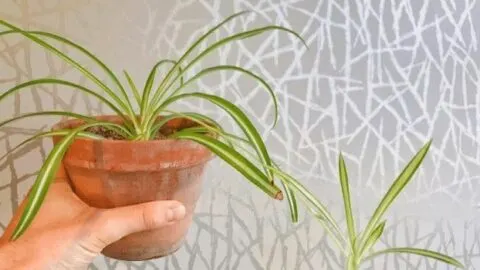The Spider Plant, or Chlorophytum comosum, by its botanical name, is a plant in the Asparagaceae family.
The University of Arkansas adds that these houseplants are also called airplane plants because of the plantlets hanging down the spindly stems.
It is one of the most popular houseplants thanks to its low maintenance, its beautiful green and variegated varieties, and the fact that it is straightforward to grow and propagate.
Spider plants grow as rosettes and propagate by producing pups or spiderettes.
It is called a spider plant because its offsprings hang down like spiders in a net.
So let’s dive into Chlorophytum comosum care to see exactly what it takes to keep our leafy indoor plant friend happy and healthy.
Table of Contents
Spider Plant Takeaways
| Species | Chlorophytum comosum |
| Synonyms | spider plant,common spider plant,airplane plant,ribbon plant,spider ivy |
| Family | Asparagaceae |
| Genus | Chlorophytum |
| Propogation | Plantlets, root division |
| Growth | Build rosettes feet |
| Height | 1.25 feet |
| Soil | Regular well-draining potting soil with added sand and perlite |
| Watering | Water every to 7 days |
| Light | Bright indirect |
| Temperature | 65 to 77°F |
| Humidity | 60-80% |
| Fertilizer | Fertilize 1 times per month |
| Propagation | Plantlets, root division |
| Toxicity | Non-toxic to animals such as cats and dogs as well as humans |
Spider Plant Care
To care for a Chlorophytum comosum, provide a general well-draining potting soil with added sand and perlite. Provide bright indirect sunlight. Water once a week in the growing season and every 2-3 weeks in autumn and winter. They grow at a temperature between 65-77°F (18-25°C). 60% humidity and higher is perfect, but these houseplants tolerate lower humidity well. Fertilize once a month with a diluted fertilizer at half-strength in the growing season in spring and summer.
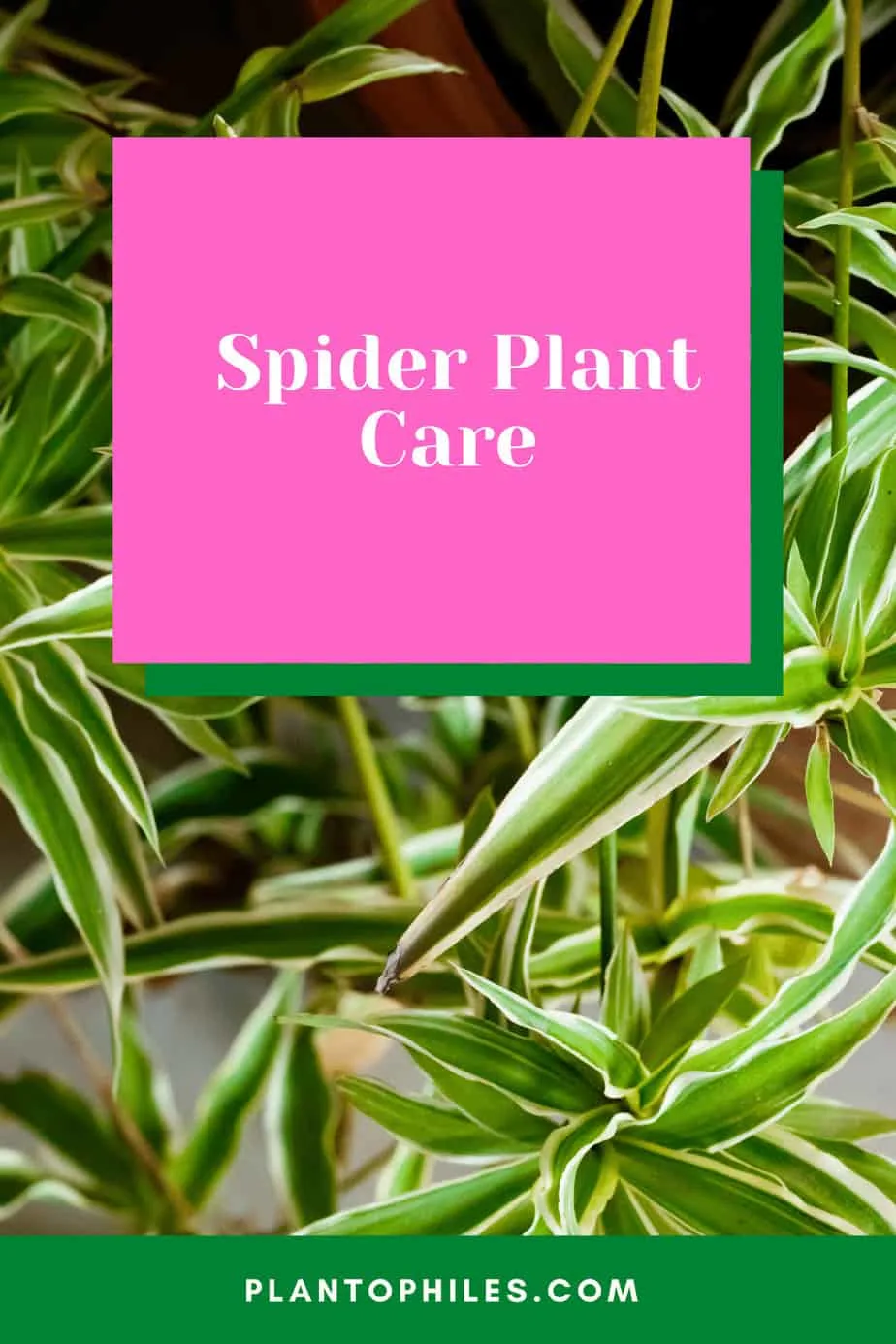
Grow And Care For Spider Plants
Spider plant care is easy. They are easy to propagate and easy to grow.
The University of Florida summarizes Chlorophytum comosum care and calls it a plant that thrives on neglect.
Soil
Spider plants prefer general soil, although they grow best in a potting mix containing sand or perlite. This provides a well-draining soil structure for effective drainage.
Overwatered Chlorophytum comosum is susceptible to root rot, so well-draining soil is essential.
Light
The optimal lighting is bright indirect sunlight. However, these hardy plants will still grow in semi-shady conditions and can tolerate some direct sun.
If placed in full sun (depending on your climate), these plants will start to show signs of stress (scorched or brown tips of the leaves) so don’t place them on a window sill (or any other location) that receives more than 5 hours of intense bright light.
Watering
Water once a week in the growing months in spring and summer and around every 2-3 weeks in the winter.
The roots are fleshy and tuberous as an adaptation to store water in their naturally arid, native environment. Consequently, forgetting to water your Chlorophytum comosum will be okay for a little while.
If you are unsure when to water, push your finger to a depth of one inch into the surrounding soil.
If the soil still feels quite moist, leave off watering for now. If the soil feels dry, this is the perfect time to water your plant to keep it happy.
Temperature
These plants grow best at room temperature between 65-77° F (18-25° Celsius). Spiders are capable of living in an extensive temperature range, tolerating temperatures as low as 35° F (2°C) and as high as 90°F (32° C).
They’re more than capable of handling significant seasonal temperature fluctuations.
Humidity
The optimal humidity is 60% or higher. The Chlorophytum comosum is ok with the humidity in most homes and can tolerate some of the more steamy rooms of your house, like the kitchen or bathroom.
However, if you live in a particular low-humidity climate, your plant will appreciate a quick mist on the leaves around once a week in the dry summer.
Remember that humidity can still be low in very cool climates, so a quick mist will make your leafy friend happy.
Fertilizer
A diluted fertilizer at half-strength once every month during the growing season is perfect. This natural going plant does not need a specialized fertilizer (an all-purpose house plant fertilizer is ideal); however, the plant is susceptible to over-fertilization, which turns the leaf tips brown, so go sparingly.
Propagation
They are well known for their easy propagation using the small plantlets on the end of a stem in the spring and summer. Place these plantlets into well-watered soil, and they will quickly develop a robust root system.
When the plant has taken root, you can snip away the main stem with scissors and have a fully formed mini Chlorophytum comosum.
Alternatively, you can propagate by dividing the roots in the spring during repotting.
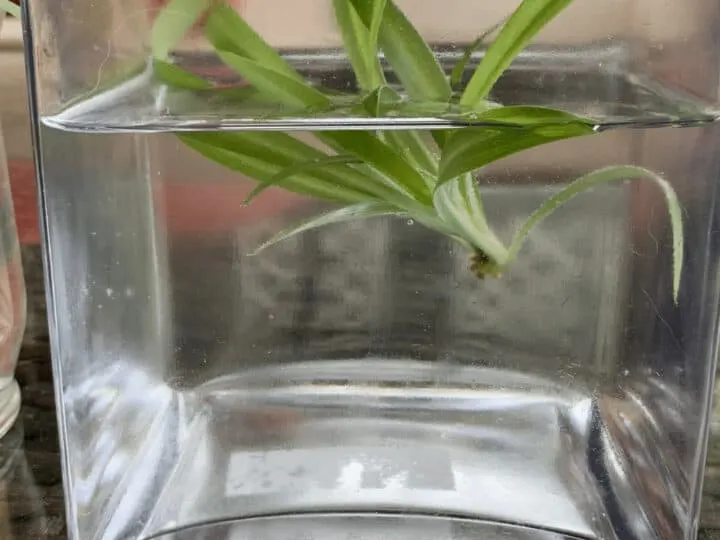
Growth
Chlorophytum comosum is a relatively quick grower for house plants, with long, slender leaves growing a few inches long every season.
The maximum spread of a mature plant in an appropriate-sized pot is around 20 inches (50 cm).
If your plant grows too big for your space, you can prune the longer individual leaves back to the stem with scissors or a sharp, sterile knife.
This will not harm the plant and will encourage fresh, new growth.
Alternatively, you can decrease the Chlorophytum comosum’s size by dividing the roots and repotting a new segment.
Potting
Chlorophytum comosum requires smaller pots. They prefer roots becoming semi-root bound and are best placed in a hanging basket as the pups will grow out of the pot and hang down.
The time to repot the Chlorophytum comosum is when several thick, white roots start to protrude up through the soil or appear through the drainage holes at the bottom of the pot.
It would be best to transplant to a bigger pot filled with fresh soil with plenty of drainage holes in the bottom.
Blooming
Spider plants produce small white flowers when they are blooming. They grow long stems that are up to two feet long.
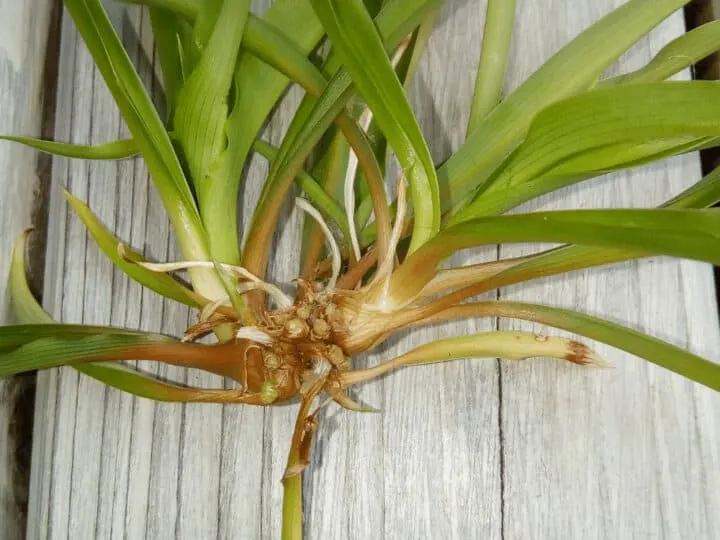
What Does the Spider Plant Look Like?
Chlorophytum comosum has long slender leaves that extend out from a basal rosette.
The long leaves tend to form evenly around the base, gently curve downwards, and can be up to 18 inches (45cm) long.
The two most popular Chlorophytum comosum cultivars (varieties) are
- Chlorophytum Comosum ‘Vittatum.’ This variety has a bold white stripe that runs down the middle of each leaf, which is boarded on either side with dark green margins.
- Chlorophytum Comosum ‘Variegatum.’ This variety has a green stripe running down the middle with silvery-white margins.
There are delicate white flowers that bloom in the spring on the end of a stem.
New plantlets are formed from the flowering stem as the plant attempts to self-propagate.
The roots are dense, white, and tuberous, which is an adaptation to its native South African climate so the plant can store water and survive periods of drought.
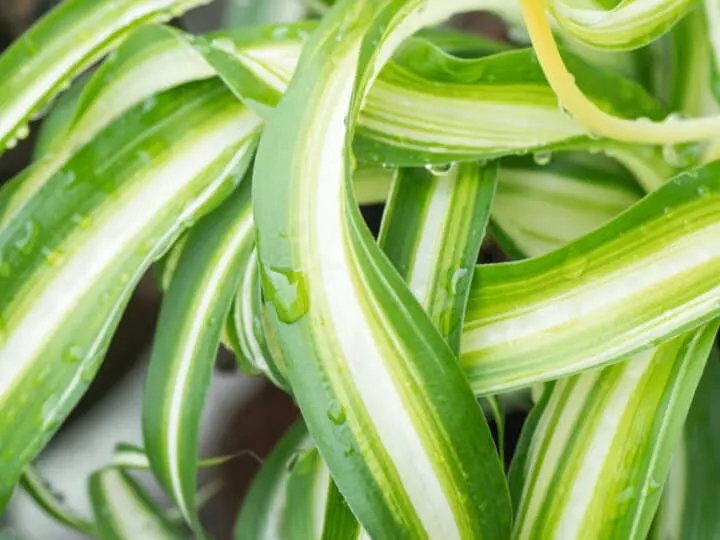
The Origin of The Spider Plant
Chlorophytum comosum is native to South Africa and thrives in various habitats, from cliffs to shady forest floors.
Chlorophytum comosum can grow at sea level to more than 3000 ft (1000 m) altitudes.
In their native range, they grow in various soils, from fertile volcanic soils to nutrient-poor sandy soils.
This adaptability to different conditions is why they make such good houseplants.
They are most commonly found hiding in shaded forested river valleys with well-draining soil.
The Chlorophytum comosum’s fleshy, tuberous roots system adapts to storing water in a variable climate to survive in prolonged drought periods.
Chlorophytum comosums have been introduced to other countries and naturalized in Western Australia, where they spread quickly because of their propensity to self-propagate.
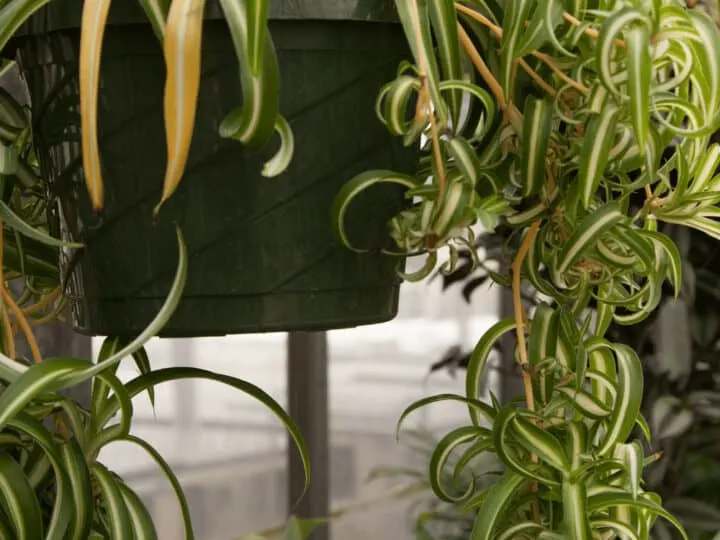
Spider Plant Propagation
A Spider plant is possibly the easiest house plant to propagate as they do most of the work for you.
The two easiest ways to produce new plants are:
- Propagation of plantlets
- Propagation by dividing the roots during repotting
Chlorophytum comosum natural reproduction method in their native South Africa is by self-propagating its little plantlets that form on the end of the flower stems during the growing season.
These are small, fully-formed rosettes with leaves and a developing root system.
Spider Plant Propagation From Plantlets
The method of propagation with the highest success rate is, without a doubt propagating the plantlets that the plant produces naturally every year.
Rather unusually for a house plant, a Spider plant enjoys being pot-bound. When the roots are in a tight interlocking mass, the plant will produce more flowers in the spring.
The flowers form on the end of a stem, which then develops into a new individual plantlet.
This plantlet will look like a small rosette of leaves with a small developing root system.
The stem will gradually droop towards the soil in search of a new place for the plantlet to set its roots.
If you have the space in your home, you can place a fresh pot of soil next to the parent plant for your new plantlet to land on.
The pot should be filled with general potting soil with sand or perlite mixed in (an equal measure of soil and sand is perfect) and watered so the soil is moist.
It will benefit the plantlet if the soil remains moist (without being saturated), as the developing roots will not be able to store water the same way as the mature plant can, so your plantlet will need more care and attention.
Once the plant has been in the soil for a couple of days, and the roots have a chance to establish, you can use a sterile pair of scissors and cut the attaching stem (close to the new plant) to separate the plantlet from the parent plant.
Keep your new plant in bright yet indirect sunlight as you would with a mature specimen, but while the roots are developing, you should water around the base once every two days.
After two weeks, the roots will be more developed, and you should reduce watering to a cycle of one good soak every week in the growing months and once every two or three weeks in the coming winter.
Alternatively, if you have formed multiple plantlets and plan to propagate them all, you can wait for the leaves and roots of the new rosette to develop on the stem.
Cut the stem with scissors close to the base of your new plantlet to place it on moist soil in a new pot so the roots can work their way in and begin to establish.
Again, I should emphasize that it is crucial to keep the soil somewhat moist in the first couple of weeks as the new roots cannot store water yet, but after the two weeks are up, you can start watering just once a week.
There is no need for any hormone rooting powder or other special conditions.
Chlorophytum comosum wants you to propagate them, and they will make it as easy as possible!
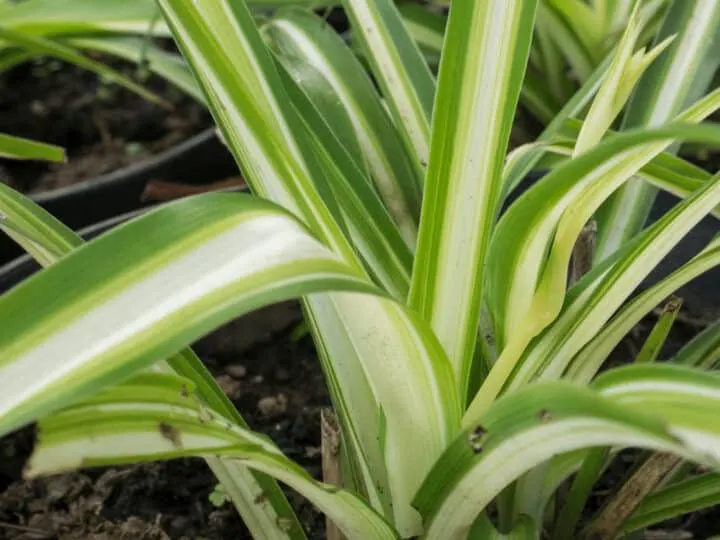
Chlorophytum comosum Propagation By Root Division
Another successful way to propagate the Spider plant is to divide the roots when you repot the plant. This is best done at the start of spring; however, you can still successfully divide roots at any time during the warmer months.
Remember that the Chlorophytum comosum actually likes its roots pot bound in a dense mass, so you don’t necessarily need to repot and propagate the plant for this reason.
However, suppose the white fleshy roots are protruding out of the soil and appearing through or blocking the drainage holes in the bottom of your pot. In that case, you must repot the plant, which is a great opportunity to divide the roots for propagating.
Take the plant out of the pot and inspect the root ball.
You can rinse away some of the soil to see the roots more clearly, so you can work out how to untangle them.
Identify a clump of roots attached to the stem that you are trying to separate away from the parent plant and work the roots apart with your hands.
If the roots are too tangled for a clean getaway, use a sterile knife or scissors and make tactical cuts to free your segment from the main plant.
Once you have successfully separated the segment, pot your divided plant into fresh potting soil and give it a generous soak.
If you had to slice through a significant amount of the root system, water the plant once every two or three days for the first couple of weeks and then return to a normal watering cycle of one good soak every week during the growing season.
Chlorophytum comosum is adaptable, so don’t be afraid to make tactical cuts to the roots if necessary.
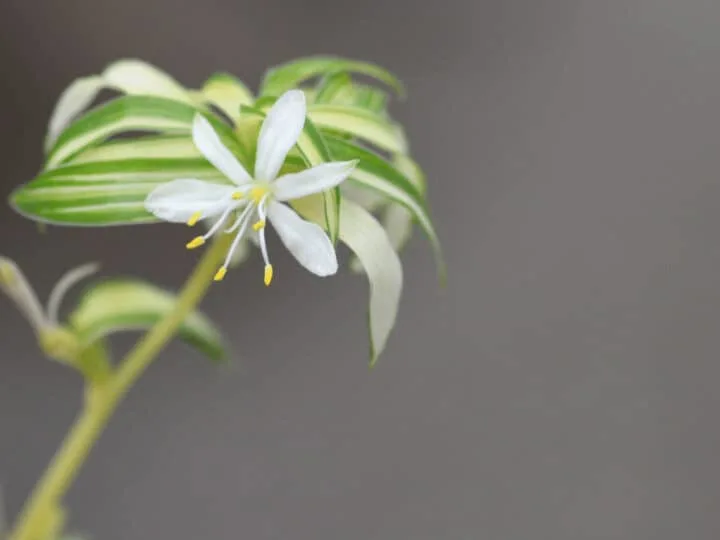
Tips to Keep A Spider Plant Healthy
- Do mist your Chlorophytum comosum in very dry weather. If you live in a hot, dry climate with low humidity, spray your Chlorophytum comosum with a mister about once a week. If the leaf’s tips are brown, this is a sign of stress due to the lack of humidity. Keep it misty if it’s dry in the growing season, but the plant should be happy in the winter without misting it.
- Do keep your plant away from cats! Chlorophytum comosums are NOT toxic to cats or dogs, but they do have a hallucinogenic quality similar to catnip if cats consume them. While it is not toxic, if your cat consumes a significant amount of the plant’s leaves, the opium-like compounds will upset your feline friend, which shouldn’t be serious, but you should still seek advice from your vet immediately.
- Plant your Chlorophytum comosum in a pot with drainage holes. The fleshy, white roots hate sitting in stagnant water, so free drainage is necessary. Be careful if your pot is on a saucer or something that retains water, as the plant likes to keep its feet dry to avoid root rot.
- If you have a variegated species of Chlorophytum comosum (mixed coloration of the leaves), place your plant in bright indirect sunlight. The contrast between the silvery white stripe and the green margins of Chlorophytum comosum ‘Variegatum’ becomes bolder in brighter light. However, this plant does not like extended periods of direct light, so keep the light bright, but not directly on the plant!
Spider Plant Toxicity
Spider plants are pet-friendly. They are non-toxic to cats, dogs, and humans, according to ASCPA.
Spider Plant Problems
Brown Tips
The biggest problem regarding Chlorophytum comosum care is the brown tips on spider plant leaves. These are mostly caused because of fluorides and chlorides in the water that will scorch the leaf tips.
To remedy this situation. Let tap water sit for 12-24 hours before watering your spider plant so the fluorides dissipate, or use rainwater or distilled water.
Curly Leaves
If the Chlorophytum comosum is stressed through incorrect watering, too low or too high temperatures, incorrect humidity, or pests, it can react by curling its leaves.
There is also a naturally curly variety, the Curly Spider plant. If you own a common spider plant and the leaves are curling, it is a sign that you need to change one or multiple care aspects.
Root Rot
When you are overwatering your plant, it will result in root rot. Too often than not, the wrong potting soil is one of the leading causes. If the soil is too dense and you are watering too frequently, oxygen can no longer reach the plant roots.
This can lead to root rot.
Read the article about root rot in spider plants.
6 Things You Should Not Do When Caring For A Spider Plant
- Keep your Chlorophytum comosum away from draughts or air currents caused by radiators or air conditioners. Remember, the Chlorophytum comosum natural environment tends to be subtropical and shady with some humidity. Draughty areas can dry the plant out, so keep it in a nice still spot, and your leafy friend will thank you for it.
- Do not overwater your plant. The Chlorophytum comosum is particularly hardy and only needs to be drink once a week. The roots are specially adapted for storing water for times of drought, so don’t worry if you forget to water for longer than a week; spider plants are very forgiving!
- Do not over-fertilize your plant. Chlorophytum comosums are super low maintenance, and a general diluted houseplant fertilizer once a month during the growing season is all they need to stay green and happy. Brown, dry-looking leaves are a sign of stress due to over-fertilizing. Once a month in the summer, no fertilizer in the winter is optimal.
- Don’t place your leafy friend in direct sunlight. Chlorophytum comosums are like life in the undergrowth, away from the spotlight. They occur prolifically under the forested canopy in their native range and can live in your home’s brighter or relatively low-light areas. If you have a variegated variety, the silver/color of the leaves may fade significantly, and the leaves turn to solid green in a particularly shaded area. This will not harm the variegated varieties, but it is something to be aware of.
- Don’t divide your plant in winter. The Chlorophytum comosum is a particularly tough houseplant. Still, outside of the growing season, the plant is dormant and more susceptible to stress induced by dividing and cutting roots. Dividing the plant up when repotting at the start of the growing season is a perfect time, and this resilient customer will take it in its stride.
Should I cut the babies off my Spider plant?
You can cut the babies off your Spider plant, but you don’t have to. The spider plant babies use a lot of energy from their mother plants. Therefore additional fertilizer and water could be saved when the babies are cut off.
Can a Spider plant recover from spider mites?
A plant can recover from a spider mite infestation as long as it is identified early. Clean the plant leaves with neem oil and a mix of a couple of drops of dishwater soap and water. If some of the plant leaves are heavily invested, remove them.
How much sun does a spider plant need?
A spider plant grows best under bright indirect light. It will also grow when only moderate light is available, but the growth rate is much better under brighter light conditions. These plants can also be grown using artificial lighting such as grow lights.
What does an overwatered Spider plant look like?
An overwatered plant will look discolored, almost grayish. Its leaves will be flimsy, thin, and soft. They can also be curled and even wilted. The reason is that overwatering leads to root rot, where plant roots cannot take any water and nutrients in anymore. This is why overwatering can resemble underwatering as in fact; the plants cannot take in sufficient water anymore.
Should I cut the brown tips off my Spider plant?
You should cut off the brown tips on your plant. Brown tips are often a cause of hard chlorinated water. When cutting off the brown tips, you will prevent the dried-up brown areas will spread along the whole leaf. However, you can also leaf the brown tips on your plant, but they might look unsightly, and the area of dead plant tissue might spread across the leaf.
Where is the best place to put a Spider plant?
The best place to put a Spider plant is close to an eastern-facing window. You can put your plant either in an eastern- or western-facing window. These window directions offer a lot of bright indirect light and only a couple of hours of direct light. The eastern-window direction provides 3-4 hours of direct sunlight in the morning. This is perfect as the sunlight is not as strong at that time.
Put your plant very close but not too close to a window, as it will be exposed to too much heat in the summer and cold drafts in the winter.
How do I know if my plant has Spider mites?
If you see small webs and small white dots across your leaves, you know that you have Spider mites. Spider mites are very hard to see. They are small, circular, and white and look like spiders. If you have a spider mite infestation, you will see small spider webs on the leaves. The spider mites themselves are small white dots.
How do I identify a Spider plant?
A spider plant has thin linear, pale green, pinnate leaves that emerge from a crown/center, a rosette. The leaves are smooth. The variegated form has green leaves with white bands, whereas the leaves of the green form are entirely green. These plants form babies across the plant that are called spiderettes. They grow on the mother plants and will hang down.
Frequently Asked Questions
Why are the leaf tips of my spider plant brown?
The leaves of a spider plant mostly get brown if you use tap water containing many salts, chlorine, and minerals. Use rainwater, reverse osmosis water, distilled water, or let tap water sit for at least 24 hours.
How to propagate a spider plant?
To propagate a spider plant, just cut off one of the pups, starting to form over time. Put it directly into the soil or grow the plantlet in water until it develops its roots.
How much light does a spider plant need?
A spider plant grows best in bright indirect light. It will also tolerate low-medium light but will only grow slowly and will certainly not thrive.
How to fertilize a spider plant?
Fertilize a spider plant using a balanced liquid fertilizer once a month at half-strength in spring and summer. Do not fertilize in autumn and winter.
Conclusion on Spider Plant Care
The ideal temperature is 65-77 degrees Fahrenheit (18-25 degrees Celsius). Provide well-draining potting soil using sand, perlite, and potting soil. The best humidity is 60% or more, although these plants tolerate lower humidity. Fertilize every month in spring and summer using a liquid fertilizer at 1/2 strength. Fertilize every other month in autumn and winter.

Daniel has been a plant enthusiast for over 20 years. He owns hundreds of houseplants and prepares for the chili growing seasons yearly with great anticipation. His favorite plants are plant species in the Araceae family, such as Monstera, Philodendron, and Anthurium. He also loves gardening and is growing hot peppers, tomatoes, and many more vegetables.

